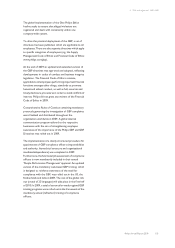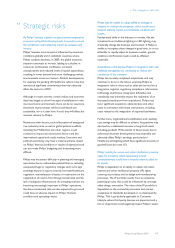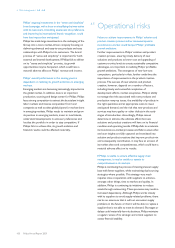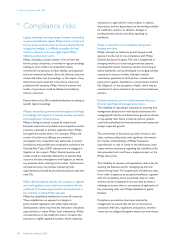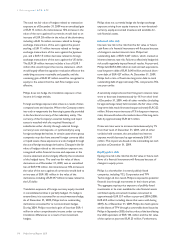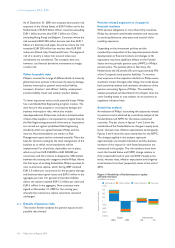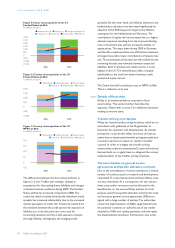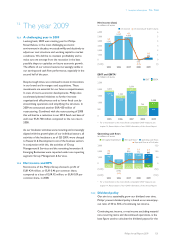Philips 2009 Annual Report Download - page 115
Download and view the complete annual report
Please find page 115 of the 2009 Philips annual report below. You can navigate through the pages in the report by either clicking on the pages listed below, or by using the keyword search tool below to find specific information within the annual report.
Philips also held options on the shares of CBAY through a
convertible bond issued to Philips in August 2008, the face
value of the bond being the USD equivalent of EUR 67
million and the fair value of the option at year-end EUR 2
million. Philips does not hold derivatives in its own stock
or in the above-mentioned listed companies except for
the embedded derivatives in the convertible bonds
already mentioned.
Philips is also a shareholder in several privately owned
companies including NXP. As a result, Philips is exposed
to potential value adjustments.
Commodity price risk
Commodity price risk is the risk that the fair value or
future cash flows of a financial instrument will fluctuate
because of changes in commodity prices.
Philips is a purchaser of certain base metals, precious
metals and energy. Philips hedges certain commodity price
risks using derivative instruments to minimize significant,
unanticipated earnings fluctuations caused by commodity
price volatility. The commodity price derivatives that
Philips enters into are accounted for as cash flow hedges
to offset forecasted purchases. As of December 2009, a
gain of less than EUR 1 million was deferred in equity as a
result of these hedges. A 10% increase in the market price
of all commodities as of December 31, 2009 would
increase the fair value of the derivatives by less than EUR 1
million.
Credit risk
Credit risk represents the loss that would be recognized
at the reporting date if counterparties failed completely to
perform their payment obligations as contracted. Credit
risk is present within Philips trade receivables. To have
better insights into the credit exposures, Philips performs
ongoing evaluations of the financial and non-financial
conditions of its customers and adjusts credit limits when
appropriate. In instances where the creditworthiness of a
customer is determined not to be sufficient to grant the
credit limit required, there are a number of mitigation
tools that can be utilized to close the gap including
reducing payment terms, cash on delivery, pre-payments
and pledges on assets.
Philips invests available cash and cash equivalents with
various financial institutions and is exposed to credit risk
with these counterparties. The analysis below includes
short-term deposits which were the main component of
cash and cash equivalents totaling EUR 3,740 million as of
December 31, 2009 (2008: 2,847 million). Philips is also
exposed to credit risks in the event of non-performance
by financial institutions with respect to financial derivative
instruments.
Philips actively manages concentration risk and on a daily
basis measures the potential loss under certain stress
scenarios, should a financial institution default. These
worst-case scenario losses are monitored and limited by
the company. As of December 31, 2009 Philips had credit
risk exceeding EUR 25 million with the following number
of financial institutions:
Credit risk with number of counterparties
25-100
million
100-500
million
500-2,000
million
AAA-rated governments − − 1
AAA-rated government banks − − 2
AAA-rated bank
counterparties − − 1
AA-rated bank counterparties 2 − −
A-rated bank counterparties 3 1 −
5 1 4
The company does not enter into any financial derivative
instruments to protect against default by financial
institutions. However, where possible the company
requires all financial institution with whom it deals in
derivative transactions to complete legally enforceable
netting agreements under an International Swap Dealers
Association master agreement or otherwise prior to
trading, and whenever possible, to have a strong credit
rating from Standard & Poor’s and Moody’s Investor
Services. Philips also regularly monitors the development
of the credit risk of its financial counterparties. Wherever
possible, cash is invested and financial transactions are
concluded with financial institutions with strong credit
ratings or with governments or government-backed
institutions. For an overview of the overall maximum
credit exposure of the group’s financial assets, please
refer to note 32 for details of carrying amounts and fair
value.
Country risk
Country risk is the risk that political, legal, or economic
developments in a single country could adversely impact
our performance. The country risk per country is defined
as the sum of the equity of all subsidiaries and associated
companies in country cross-border transactions, such as
intercompany loans, accounts receivable from third
parties and intercompany accounts receivable. The
country risk is monitored on a regular basis.
6 Risk management 6.7.2 - 6.7.2
Philips Annual Report 2009 115


